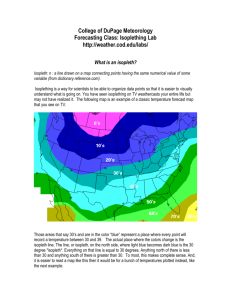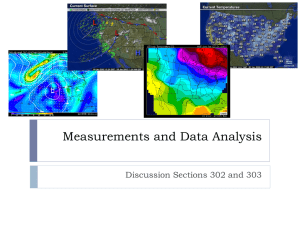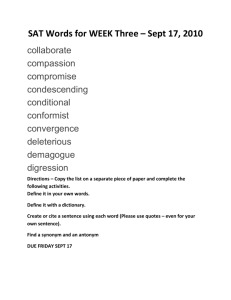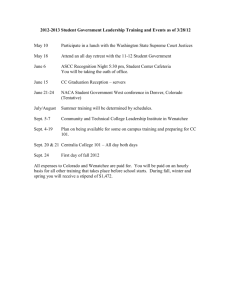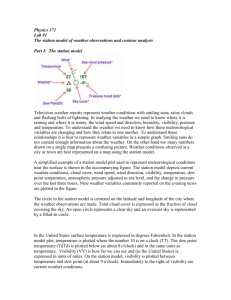Assignment 1: Due Sept 5
advertisement
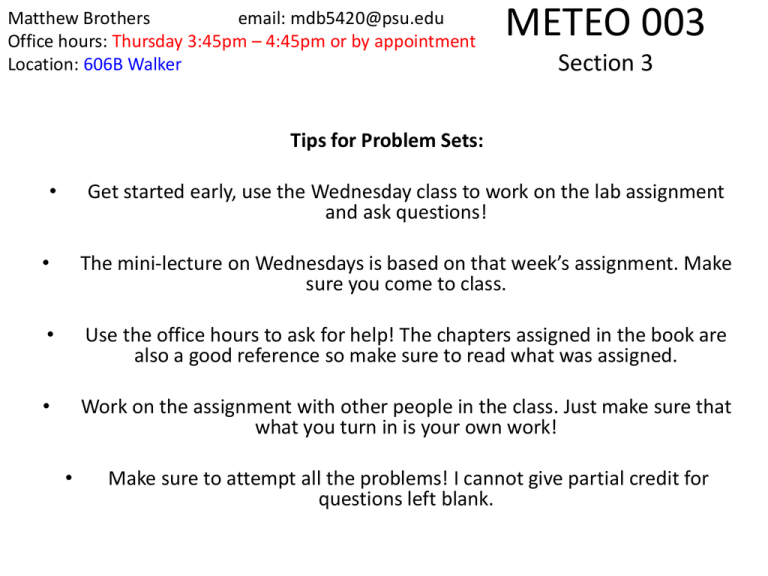
Matthew Brothers email: mdb5420@psu.edu Office hours: Thursday 3:45pm – 4:45pm or by appointment Location: 606B Walker METEO 003 Section 3 Tips for Problem Sets: • Get started early, use the Wednesday class to work on the lab assignment and ask questions! • The mini-lecture on Wednesdays is based on that week’s assignment. Make sure you come to class. • Use the office hours to ask for help! The chapters assigned in the book are also a good reference so make sure to read what was assigned. • Work on the assignment with other people in the class. Just make sure that what you turn in is your own work! • Make sure to attempt all the problems! I cannot give partial credit for questions left blank. Assignment 1: Due Sept 5 • Chapter 1 Problem 1a and b – consult google if you are not sure Problem 4 – pages 8 and 10 in the text are helpful How to Isopleth • Isopleth – line of equal value • Uses of isoplething: – See patterns in data – Estimate values where no data is observed How to Isopleth • Isopleth – line of equal value • Uses of isoplething: – See patterns in data – Estimate values where no data is observed • Common isopleths in meteorology: – Isobar: line of equal pressure – Isotherm: line of equal temperature – Isodrosotherm: line of equal dew point How to Isopleth 1. Pick a value to isopleth first 2. Find a location on the map where this value is observed 3. Draw a line so locations on one side of your line have greater value and locations on the other side of the line have a lesser value 4. Stop drawing once you reach an edge of the data or the line closes on itself (circle) 5. Label the isopleth *Analysis should be neat & smooth, not jagged & messy *Isopleth only the area on the map where data is available Example Assignment 1: Due Sept 5 • Chapter 1 Problem 1a and b – consult google is you are not sure Problem 4 – pages 8 and 10 in the text are helpful Problem 7a,b,c – tips 1/ Find the multiple of 10, example 30⁰F 2/ Look at the numbers around it, and decide which way to proceed 3/You want to draw your 30⁰ line so that it is closer to 28⁰ than to 34⁰ Gradients • Gradient of B = Change in Value of B Distance • Isopleths close together = large gradient • In general, large gradients in weather variables point toward interesting meteorological activity Assignment 1: Due Sept 5 • Chapter 1 Problem 10a, c, d, e Ex: the green line starts at 1000 ft and goes to 4000 ft, over 30 km 4000𝑓𝑡 − 1000𝑓𝑡 3000𝑓𝑡 = = 30 𝑘𝑚 30 𝑘𝑚 𝑓𝑡 100 𝑘𝑚 So the gradient for the green trail is 100 ft/km Wind Direction • EAST WIND = Winds are coming from the EAST and moving WEST • Easterly Wind = From the East • Eastward Wind = From the West Assignment 1: Due Sept 5 • Chapter 2 – Don’t forget to Convert to Kelvin Problem 1a, b, c and 6 use Stefan-Boltzmann equation E = σT4 Ex: If sun’s temp is 5538⁰C and your skin is 32⁰C Sun: E = σ *(5811.15 K)4 Person: E = σ*(305.15 K)4 𝐸 𝐸 4 σ ∗(5811.15 K) = 4 = 131521 σ ∗(305.15 K) So the ratio of the energy emitted per unit area by the sun to the energy emitted per unit area by a person is 131521 to 1 Assignment 1: Due Sept 5 • Chapter 2 Problem 2 – Wein’s Law Ex: If Mars has a surface Temperature of -60⁰C, then the wavelength for maximum emission on Mars is: λ= 2897 μ𝑚 𝐾 𝑇 = 2897 μ𝑚 𝐾 213.15 𝐾 and λ = 13.59 μm = Assignment 1: Due Sept 5 • Chapter 1 - 1a,b, 4, 7a,b,c, 10a,c,d,e • Chapter 2 – 1a,b,c, 2, 6 Useful equations From pg 10 ⁰F = (9/5)⁰C + 32; ⁰C = 5/9(⁰F - 32); ⁰C = K - 273.15 From pg 57, the Stefan-Boltzmann equation E = σT4 From pg 75, Wein’s Law λ = 2897 μ𝑚 𝐾 𝑇 • Units give numbers meaning, so don’t forget them • Please don’t forget to convert your temperatures to Kelvin
